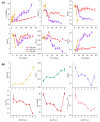The Impact of Humidity in the Thermal Ageing of Celluloid: An Inter-Scale Investigation
- PMID: 40574176
- PMCID: PMC12197267
- DOI: 10.3390/polym17121648
The Impact of Humidity in the Thermal Ageing of Celluloid: An Inter-Scale Investigation
Abstract
The role of humidity on the ageing of celluloid is investigated by performing accelerated ageing tests on mock-up samples. At 70 °C, three levels of relative humidity (RH) are selected: 30%, 50%, and 70%. Samples are monitored for the macro- and micro- changes occurring through ageing to relate the visible modifications to the molecular ones. Infrared and Raman spectroscopy, microscopy, mass and contact angle measurements, profilometry, and colourimetry are combined for this purpose. While the ageing test at 30% RH results in a slight embrittlement of the samples and small spectral changes, the one at 50% RH induces significant modifications at the molecular level and the formation of cracks, while the one at 70% RH causes a fast deformation of the samples and the development of bubbles. Although quite diverse, such results prove to be related to the same chemical processes: denitration, chain scission, and oxidation. These occur more promptly or extensively based on humidity level, resulting in different outcomes. Beyond morphology and brittleness, macroscopic effects also involve mass loss, surface roughening, and yellowing. A possible correlation between the macro and micro modifications is present, highlighting the influence humidity has on the degradation process of celluloid.
Keywords: ATR-FTIR spectroscopy; Raman spectroscopy; ageing; celluloid; cultural heritage; electron microscopy.
Conflict of interest statement
The authors declare no conflicts of interest.
Figures





References
-
- Shashoua Y. Conservation of Plastics: Materials Science, Degradation and Preservation. 1st ed. Elsevier; Amsterdam, The Netherlands: Butterworth-Heinemann; Oxford, UK: 2008.
-
- Elsässer C., Micheluz A., Pamplona M., Kavda S., Montag P. Selection of Thermal, Spectroscopic, Spectrometric, and Chromatographic Methods for Characterizing Historical Celluloid. J. Appl. Polym. Sci. 2021;138:50477. doi: 10.1002/app.50477. - DOI
-
- Chandler C.F. Presentation Address. J. Ind. Eng. Chem. 1914;6:156–158. doi: 10.1021/ie50062a020. - DOI
-
- Hyatt J.W. Address of Acceptance. J. Ind. Eng. Chem. 1914;6:158–161. doi: 10.1021/ie50062a021. - DOI
-
- Springate M.E. Cellulose Nitrate Plastic (Celluloid) in Archaeological Assemblages: Identification and Care. NEHA. 1997;26:63–72. doi: 10.22191/neha/vol26/iss1/5. - DOI
Grants and funding
LinkOut - more resources
Full Text Sources
Miscellaneous

